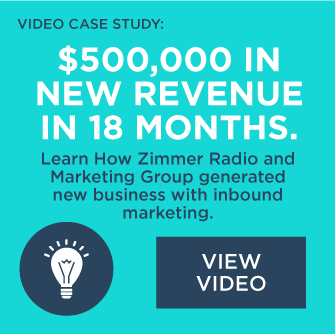Where Should You Post Your Content?
For a long time, we recommended hosting all your content on your own website — after all, you own your content, and you want people spending time on...
-406484-edited.jpg)
In 2015 (yes, five years ago!), I published, “3 Things Every Media Company Needs to Do in 2015,” and it was one of LeadG2's top-performing blog posts.
I consider myself uniquely qualified to write about this topic because I spent the first half of my career selling advertising at a media company and the second half (so far) consulting media companies on their B2B marketing, lead generation, and sales enablement needs, with a focus on helping them drive new, local direct business.
 Here’s the thing—NOTHING HAS CHANGED. Well, technically, everything has changed since 2015, but three of the top things that media companies should be doing to grow their business and evolve with the rapidly changing needs of buyers—in my humble opinion— have not changed. And most media companies have still not gotten on the train.
Here’s the thing—NOTHING HAS CHANGED. Well, technically, everything has changed since 2015, but three of the top things that media companies should be doing to grow their business and evolve with the rapidly changing needs of buyers—in my humble opinion— have not changed. And most media companies have still not gotten on the train.
Because most of you haven’t taken my advice yet, and because my experience has grown and the inbound marketing methodology has evolved (along with the buyer's journey), I thought it would be a good idea to revisit these three opportunities and tweak them to what I now know to be true.
Let’s be clear here; I’m not talking about your corporate website that doesn’t really share who you are on the market level or the power of your stations, solutions, personalities, and more.
And I’m also not talking about your station or publication websites that are viewer/listener/reader focused.
I’m talking about a place where local business owners and decision makers can find information on your company, your team members, the unique solutions you sell, the ways you help solve the problems they face, examples of others—like them—that you’ve helped, and the vast knowledge you have in marketing and advertising best practices. A place where you can establish thought leadership, trust, and credibility. Where you can educate prospects and customers alike, showcasing your unique areas of expertise that will help you get (and keep) their business. And where the strategy is focused around turning ideal prospects into sales qualified leads.
It all starts here. When business owners and marketing directors are searching for answers online to the questions they have – are they coming across your website or that of a competitor in your market? Thanks to Google, the power is in the buyer’s hands now, and we need to meet them where they are (hint: online)!
A website that is static and lacking in content and calls-to-action is a good first step, but isn’t going to help you generate leads and drive new business. A functional, professional, educational website that serves as a lead generation machine, that's where the magic happens!
Media companies have relied for far too long on only having an outbound sales approach (i.e. salespeople finding qualified prospects and cold calling). While we’re big believers here that cold-calling is far from dead (when done correctly), we also think that the smartest companies are boosting their salespeople's outbound efforts with inbound lead generation initiatives that help them find warmer leads more ready to engage.
Buyers don’t just want to be educated; they expect it. The paradigm has shifted from sellers having all of the control in the sales process to buyers having more access to research, articles, resources, and references long before they ever have to (or want to) talk to a salesperson. Think about your own buying experience, it’s likely that before you walked into that store or clicked “buy” on that website, you did all of your own research on your own time to get you to that point.
When it comes to B2B buyers, the journey is no different. But the question becomes – if your potential advertisers aren’t finding you online, who are they finding? Where are they getting the information and answers they seek?
With thousands (millions!) of articles and information at their fingertips, it’s critical that your salespeople are having some control over this educational process. This is where having sales enablement content for your salespeople to distribute – as well as that is easily found online—will make all the difference.  By having an inbound marketing strategy and B2B website and blog, you’ll have a plethora of resources and content that directly correlate to the different sales scenarios your salespeople face on a daily basis. This includes items like:
By having an inbound marketing strategy and B2B website and blog, you’ll have a plethora of resources and content that directly correlate to the different sales scenarios your salespeople face on a daily basis. This includes items like:
This content needs to be shared regularly by your salespeople on social media, in sales emails, and before and after meetings, and throughout the many stages of the sales process.
There are a wealth of sales enablement tools available that will help your salespeople act faster and smarter with every single sales interaction they are having. Some of my favorite pieces of technology to use in the sales process include:
This is just to name a few. There are many more, and they’re pretty exciting! When used correctly, your salespeople are going to be that much smarter and will be able to spend less time guessing, wondering, or wasting their time with the wrong prospects, and more time doing what really generates sales, while also reducing overall friction in the sales process and impressing potential buyers.
If you don’t have a technology roadmap in place for your sales team already (this includes sales enablement tools and also a CRM), then the time is now to start building this into your budget and strategy so that your organization isn’t left in the dust.
In addition to the technology options available to enable the sales process, one foundational resource I recommend every sales organization has is Sales Plays. These are step-by-step roadmaps that outline every step you want your salespeople to take in any given sales scenario. It includes links to relevant resources, email templates, call scripts, and more. Again – the goal here is to help your salespeople work smarter and faster!
Learn more about sales plays here.
If you work in TV, radio, print, outdoor, or any other traditional media space—then you know that the media industry and how people buy advertising is changing rapidly. While technology and the B2B buyer’s journey evolves, we must too. It might feel easier to put your head down and focus solely on expanding your service offerings and hitting that next revenue goal, but in my experience, it’s only going to get you so far.
I believe it’s the most innovative and forward-thinking organizations that are going to make the biggest impact and see true growth in the years to come, and these three tips are a good place to start. It’s about setting your sales organization up for success not just now, but for years to come. The question shouldn’t be “what does this cost to do?” but instead, “what will it cost us if we don’t do this?”


For a long time, we recommended hosting all your content on your own website — after all, you own your content, and you want people spending time on...

Learning from your peers is one of the best ways to see if you should get started with inbound marketing, or whether you're on the right path to...

From the moment I started working with the team at Zimmer Radio & Marketing Group, I had a feeling they were going to do a stellar job with inbound...